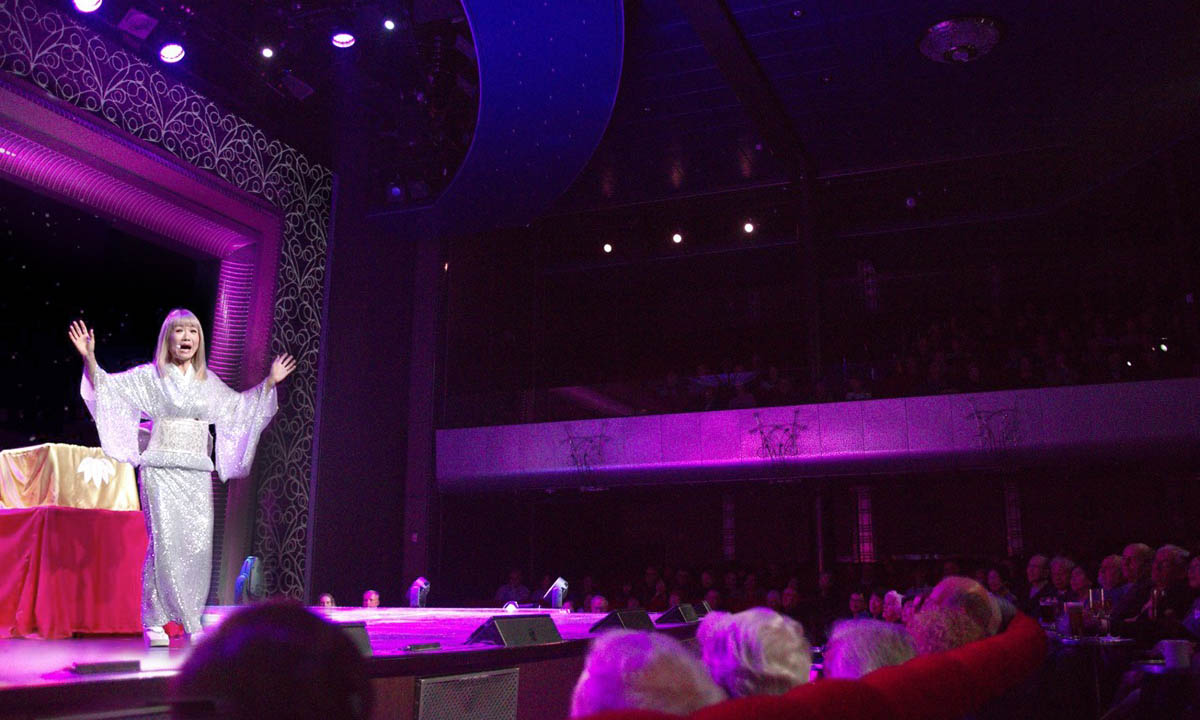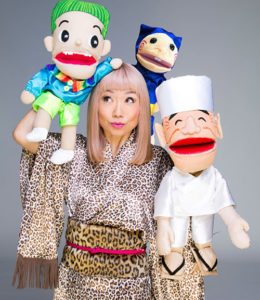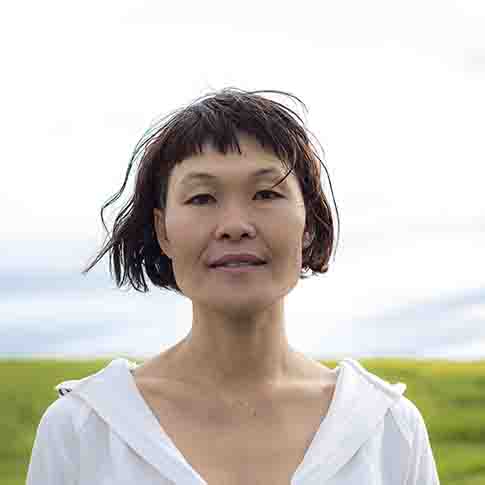
Feature
Showko Showfukutei

A ventriloquist, a Rakugo performer, and a puppet walk into a bar…
Updating 400 year old punchlines with Showko Showfukutei
Showko Showfukutei is one of Australia’s brightest entertainers who expresses her Japanese heritage through contemporary comedy. Her performance palette spans the traditional Japanese story-telling art form of Rakugo, to ventriloquism, puppetry and stand-up comedy. Showko’s trademark kimono in vivid colours, sequins and leopard print make her easily the best dressed in Australian comedy, but it’s the quirky bittersweet-ness in her story-telling which makes her one of the most memorable.
Translating the 400-year-old Rakugo tradition for contemporary and international audiences led Showko to shape an entirely unique and plural performance style. While honouring the integrity of the original Rakugo story by sharing it across cultural borders, Showko’s blended comedy expands possibilities for Rakugo performers in the present. Alison Groves interviews Showko Showfukutei on the challenges of Japanese comedy being lost in translation, the benefits of loud kimono, and puppets who reveal the secret lives of salarymen.

Alison: Those familiar with Rakugo likely have an image of the performer as seated, formally clad performer in front of a byobu folding screen, armed with the simple props of a folding fan and tenugui hand cloth. One of the first things your audience is wowed by is your signature, brilliantly colourful kimono. Showko, how did your image evolve?
Showko: Well, I like to be different! I think performing internationally is what gives me this freedom for self-expression. In Japan, the context of Rakugo is a traditional art form, so I my kimono definitely too bright, too much. But when I moved and began performing overseas in western countries I realised that if I wore traditional kimono it created a formal distance with the audience – which I really wasn’t aiming for! Wearing kimono in a much more casual style created a better atmosphere, so I sew my bright kimono to ‘break the ice’ in that sense.
These days when I return to Japan to perform in my crazy kimono the Japanese audience can accept it – because now I’m treated as a foreigner in Japan! I’ve spent a long time overseas so this aspect of my identity allows me to be myself.
I think wearing my kimono subconsciously helps me ‘switch on’ as a performer. I turn into an entertainer. When I wear kimono it just feels better!
Video: Trailer for Showko: Absolutely Normal, now on Amazon Prime Video, 2019.
I think wearing my kimono subconsciously helps me ‘switch on’ as a performer. I turn into an entertainer.
Video: Showko on Australia’s Got Talent, 2016.
A: When performing in English but with Japanese Rakugo stories, how do you navigate the risk of the punch line being lost in translation?
S: It didn’t take me long to realise that direct translations don’t work – sometimes they do, but usually not! I will usually have two versions of a story or a whole show for the jokes to work in both English and Japanese.
There are just so many elements – the theatre, audience, language – which change performance to performance, so being able to adjust things freely is really important to me.
A: For those who are yet to have the Showko experience, can you describe how audience participation elements fit in your performance style?
S: With traditional Rakugo we can’t bring the audience on stage so that’s quite a key difference! Japanese performance style is much more one-way in that sense.
My type of audience participation is slightly different to the classic stand-up style: I don’t call out members of the audience and make fun of them… but I do invite audience members to come and interact with my puppets! I often ask them to become the character of the tuna sushi puppet, prawn sushi and so on. I love bringing the audience on stage because they’re just naturally so funny when they’re asked to join in – and I can play with their reactions. Of course it can be a bit scary for them (and for me), but I write the situations to reduce the chance of failing!
A: Have you trialled this kind of interaction with Japanese audiences?
S: Well, Japanese audience members watching my shows here in Australia are totally fine with it, but when I perform at a regular comedy venue in Japan this style it can be hard. Japanese audiences simply aren’t used to it. Once I had such an awful experience where I tried some audience interaction with a Japanese guy who was just painfully shy, and everyone felt the pain of his shyness, feeling sorry for him, and I thought ‘oh no!’ So, yes, since then I decided not to use that type of audience engagement in Japan!
A: Speaking of Japanese character, the title you chose for this new show, ‘Absolutely Normal’ for me suggests the dichotomy of the common media portrayal of Japanese society as hardworking and sensible, while also housing many unexpected fringe subcultures and identities. What does ‘absolutely normal’ feel like to you, and how does performing filter your experience?
S: Well, I chose the name Absolutely Normal because…yes, I’m a middle-aged woman who is constantly talking to puppets. All my friends are puppets… ah, mm, it’s not exactly normal!
When I was just a little kid I gave the valentines chocolate to the boy I liked; he threw it away. The next day my best friend and he started dating, and I was totally broken hearted. The next time I decided to declare my love for a boy I had a much better idea: I made a puppet. But, he was scared and immediately threw it away! It was even worse than the first time. But besides that heartbreak, puppets became my outlet: I’d tell them my problems and talk it out. I had a pretty tough family life but I was able to overcome it and these puppets are part of that story.
Like you said, my puppets mirror the different types of people in Japanese society: maybe someone who looks like a normal salary-man might secretly really like to cosplay. These puppet characters are a way of balancing the light and the dark. I feel like my story and my comedy is always trying to balance bitter and funny elements together.
A: How do you think this balance of bitterness and funniness relates to Rakugo?
S: Rakugo, traditionally, is certainly funny but also has quite a lot of darkness.
One Rakugo story I use in my performances – changed to suit my style – is called ‘Cherry’. Traditionally, the story is of a guy who eats a cherry, and from the seed a cherry blossom tree grows on his head, he’s not too happy about it. People come and have hanami cherry blossom picnics, getting drunk and having a good time – he gets so annoyed that he pulls the whole tree out from his head. But from there, he’s left with a pond on his head, so then people come and enjoy fishing, and it’s becoming so noisy again. Eventually he can’t take it anymore and thinks to himself ‘oh, my life, why am I so unlucky?’ and jumps into his own pond to commit suicide. So yeah, it’s a very imaginative, quirky and dark story originally. But, I didn’t want to end my telling of the story with suicide, so I changed the so ending to go further – the character ends up jumping in the lake and swimming in their head and so on.
Importantly, all Rakugo stories were originally written for male performers: it is traditionally a men’s art form, and some of them were written 400 years ago. It’s only in the last 35 years that women have been performing Rakugo. So for a lot of these stories, as a female performer, I have to change it so it’s funny.
Video: “That’s Life” by Sushi Master & Showko, 2019.
Video: Showko at Sydney Comedy Store, 2019.
A: Were any female Rakugoka influential in your career?
S: Ah yes, Ayame Katsura has an even longer career than my master’s. She created so many new Rakugo topics and stories, using women’s stories like going to the makeup store and ending up looking identical to everyone else, mother-in-law-daughter-in-law stories, things like that. I really admire her.
A: I always feel like your stories offer such a personal touch – it’s interesting to learn that they’re so old and still remain dynamic in this sense.
S: Yes – even stand up comedy is now introducing a lot of personal storytelling; it’s a lot like Rakugo has always done.
A: How has your experience as a performer changed since the early days of your career?
S: Back 15 years ago when I first started performing in London, no one was really interested in hearing a Japanese woman with a strong accent doing comedy! It was mostly white men.
These days we’re seeing a lot more interest in what might be called minorities or people outside the mainstream. There are more Asian, African and Aboriginal people in comedy, and lesbian comedians are now very popular: it’s because they’re all offering new and really interesting stories. Back 15 years ago when I started it was so different.
A: Can you tell us about your Rakugo training and your early performance experiences in this period?
S: I received my Rakugo training in London with my master who was based there.
Very early on, my master and I realised that Rakugo really didn’t work on the street! I was wearing kimono and telling these stories…and no one was interested. They just thought we were crazy and felt sorry for us! So we decided to bring in puppetry, which fortunately worked much better!
A: How was your working relationship with your master in this period?
S: Our Showfukutei Rakugo family is famous for it’s sutesodachi attitude, which means getting thrown in the deep end, and making original ideas.
I was always with my master and observing him to learn, but it was never an expectation to copy or replicate his performance.
My master’s advice was that being onstage was one hundred times the value of the rehearsal, and he was very encouraging. He would offer a lot of advice to guide me, but always to assist, never ‘don’t do this!’.
The Showfukutei style emphasises speaking from the heart, rather than just aiming to impress audiences. It was only when I returned to Japan I realised how lucky I was to find my master, as a match for me. Other Rakugo teachers teach ‘one to ten’ in a logical system and expect you to replicate the performance of the master; it was my master who was uniquely open and innovative in this sense. He was a great innovator by introducing puppetry to Rakugo, so he was always very supportive of new ideas.
A: Looking forward, what is next on the horizon for your career?
S: I had a great experience performing for students at Washington University in the USA recently and I look forward to more opportunities to work internationally again soon. I had a real love for live stage performance but I’m also looking at pathways to other media forms including television – there’s so much to do!
Showko’s latest review from Adelaide Fringe 2019:
Video: “Japanese Stand-Up Comedian Showko for International Women’s Day on ABC,” 2017.


